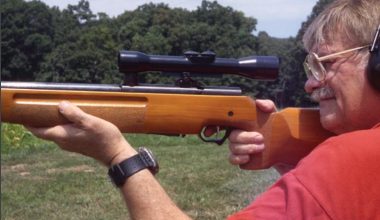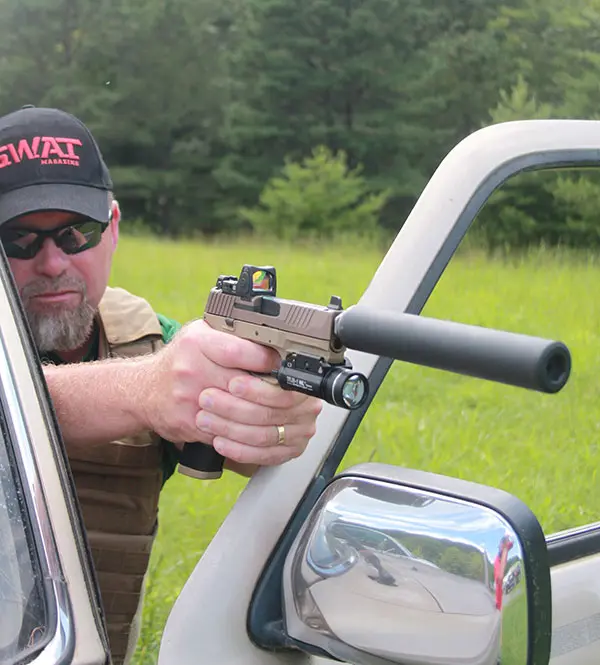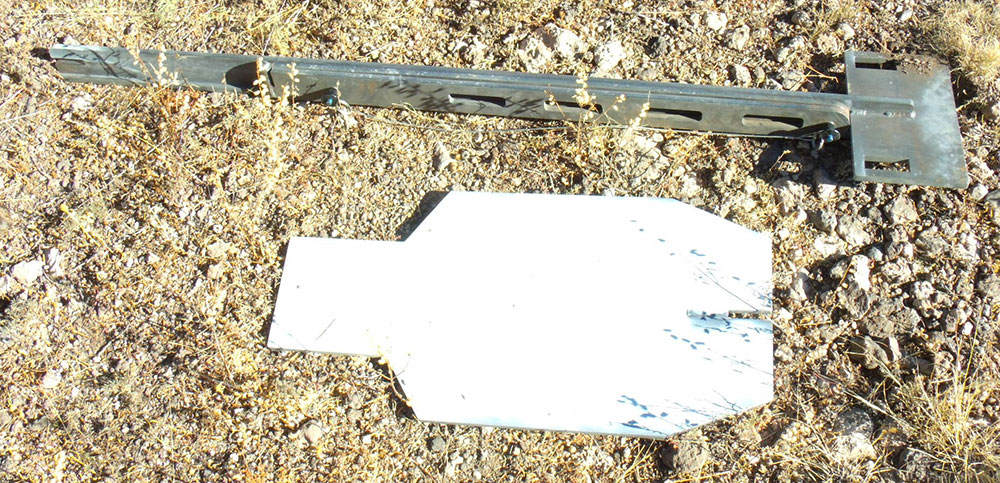
Steel targets are in demand, and why not? This is the age of instant gratification, and nothing is as gratifying as hearing lead strike steel. You know immediately if your shot was a hit or a miss.
Pistol ammo can be shot at mild steel as close as ten yards, provided the surface is smooth and the target angled with the top closer to the shooter than the bottom. The problems are the smooth surface and the target angle. Invariably, someone comes along and wants to see if his high-velocity, non-deforming bullets can penetrate the steel.
Some even try their rifle rounds. Hey, it’s only a 55-grain bullet, right? Even if they don’t penetrate, they can leave a crater, perhaps even a hole. This is a bad thing, as a later round may hit off center and some of the debris can come right back at the shooter.
The other thing that can happen is the steel starts to bend from repeated hits in the center. Practical shooters who have the old mild-steel pepper poppers know they need to reverse the impact side from time to time to straighten the steel. Sometimes it takes a hydraulic press to flatten it out.

The angle issue is important too. I have an old mild-steel target on a stand made of rebar—not very thick rebar at that. After about a decade of use, flakes of bullet started coming back at me from the still-smooth plate. The pounding had caused the legs to start to bend, bringing the plate from angled to almost upright.
I found a temporary solution by blocking the rear leg up, returning the plate to about a 20-degree angle. And I have seen several hard-steel targets where shooters can’t hit the target face but easily hit the chains holding the target, breaking them.
As a long-time “steel shooter,” there is no part of my body that has not been struck with splatter—another reason to wear glasses whenever I’m on the range, even if I’m not shooting.
Another issue with steel rifle targets is the distance you can shoot them at. I contacted one company and asked why the near limit on their rifle steel is 125 yards. They told me that if they said 100 yards, somebody would shoot it from closer and either damage the plate or get hurt.
One-hundred-yard steel can be fun, but today folks want to practice for personal protection with their carbine or rifle, and that means close-range steel or boring paper targets that require we stop shooting to score and tape. No instant gratification there!
Steel is listed as “AR,” which, while it does include steels used as “armor,” really means Abrasion Resistant. It is followed by a number indicating the actual chemical composition of the steel. The higher the number, which indicates its Brinell hardness, the more abrasion resistant the steel.
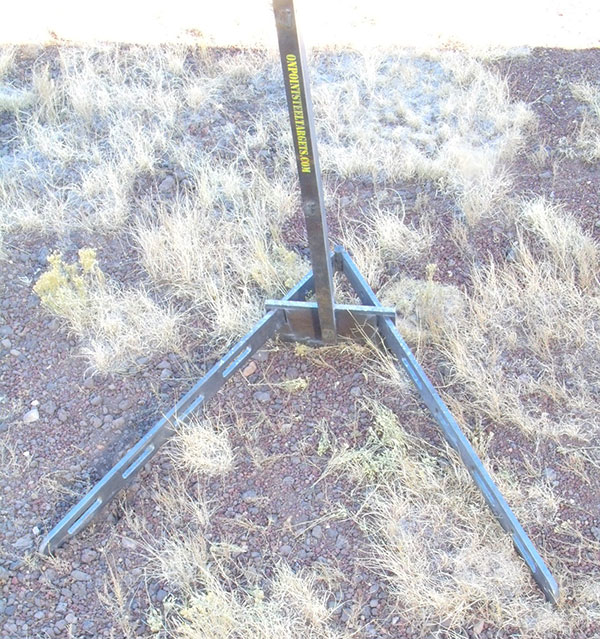
Mild steel can stand up to pistol rounds for a long time—if the bullets are running at standard and not Magnum velocities, and if the bullet construction is principally of lead with a copper jacket.
If the bullets are at Magnum velocities, you can start to dent the steel. If the bullets are of harder materials, you can start to crater the steel. Hard bullets at Magnum velocities out of pistols are a recipe for cratering or holing the targets.
Rifles are a completely different animal—it takes much harder steel to stand up to them. Even a 55-grain bullet from your AR can crater AR400 steel. Most “rifle-proof” targets are made of AR500 and will last a long time. The issue is how close you can shoot them—100 yards is the usual minimum.
There is the problem, and On Point Steel Targets has the answer. They have a combination of hard steel and a mounting system that ensures a flat surface and maintaining the proper angle. It starts with the steel—AR550.
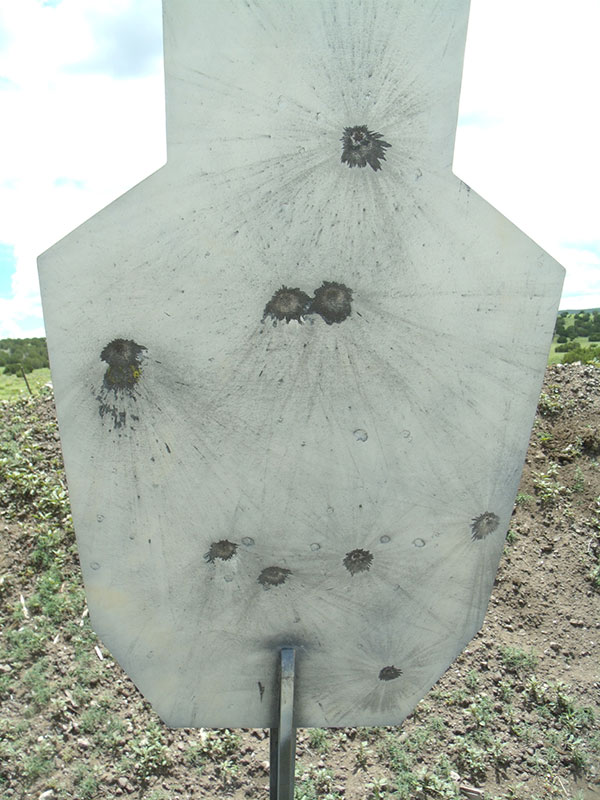
But that is not just the target face, it’s the stand as well! I did manage to hit the mount with a full metal jacket .30-06 round from close range, and all I did was disturb the paint.
The stand is two parts—two legs joined with a hinge and that slide through the bottom of the upright, forming a V. The upright has two slots at the bottom for the legs and a fork at the top to hold the target. On Point includes two push pins joined by a wire, which hold these two parts together for transport. At 30 pounds, they are not light, but they need the weight.
Pinned together, they are easy to handle. The target slides into the upper fork and stays put. Just the face weighs another 20 pounds, for a total weight of 50 pounds.
Why do they need the weight? Because you can shoot this with a non-Magnum rifle from just 25 yards! That is not a misprint—at CQB distances you can be shooting steel with your 5.56, 7.62 NATO or .30-06.
I started out at 100 yards, and .30-06 147-grain ball just scratched the paint. Then I moved to 50 yards—same result. When I got to 25 yards, I was frankly worried, not about damaging the target, but about the effects of splatter on my tender hide.
No worries! The 50-pound target and stand jumped a bit, but all I needed was a spritz of paint and the target was ready for more. Head shots with the .30-06 really punched the target hard and made it jiggle around, but it remained undamaged.

Instant gratification, no risk (I still wear glasses), and the chance to practice with my ARs, AK, even my M1 on quick, close shots. And that .30-06 round on the stand was from 25 yards. The target loaned to me had been “previously enjoyed” by a shooter who pushed the envelope. He fired a .338 Lapua Magnum at 100 yards and did manage to lightly scar the surface. Not a crater and not really a dent, but a permanent mark.
I’m not going to try my diminishing supply of 7.62 NATO AP ammo, as I don’t shoot that ammo at close range for practice. The same with my few remaining rounds of .30-06 AP—both of these are designed to penetrate hard steel. Ball ammo will give me all the training and practice I need.
If you like instant gratification and only needing a can of spray paint for target repairs, On Point Steel Targets are for you!
SOURCE
ON POINT STEEL TARGETS
www.onpointsteeltargets.com


